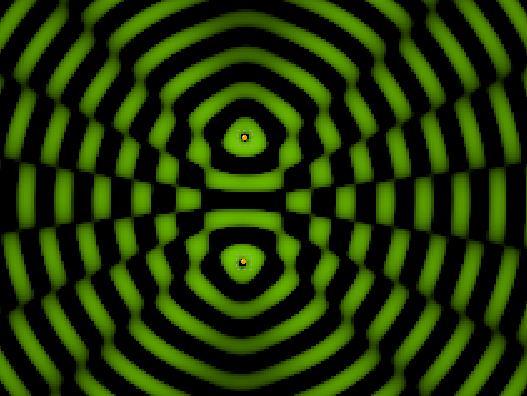As is often the case, physics is not a science that is restricted to the sterile confines of a laboratory. Physics is naturally and frequently seen by any observer who glances at the world around them. An informed physics student should see physics in action on a daily basis and should be able to exclaim without embarrassment – “that happens because of physics.” Indeed, the physics concepts and principles that we study in the Physics Classroom Tutorial simply emerge from the phenomenon that are in our world of touch and see and feel. These physics concepts and principles are simply humankind’s attempt to explain the observable. So where in this world do we observe two-point source interference? Where can we experience the phenomenon that light taking two paths from two locations to the same point in space can undergo constructive and destructive interference? There are several answers to these questions and they will be discussed in this last section of Lesson 3.
The Big Idea
Before identifying and explaining real-world examples of two-point source interference, the big idea behind it ought to be reviewed. In the second part of Lesson 3, it was noted that two coherent waves traveling along two different paths to the same point will interfere constructively if there is a difference in distance traveled that is equivalent to a whole number of wavelengths. And similarly, two coherent waves traveling along two different paths to the same point will interfere destructively if there is a difference in distance traveled that is equivalent to a half number of wavelengths. The difference in distance traveled by the waves from the two sources to the single point is referred to as the path difference. That is,
| Constructive Interference: | PD = m • λ | where m = 0, 1, 2, 3, 4, … |
| Destructive Interference: | PD = m • λ | where m = 0.5, 1.5, 2.5, 3.5, … |
These principles were presented to explain the two-point source interference patterns that are characteristic of Young’s experiment and a wavelength measurement. Yet, these principles are more general in the sense that they can explain any physical situation in which waves take two different paths from two coherent sources to the same point. Such coherent waves will undergo interference. And if the difference in distance traveled is a whole number of wavelengths, then the interference will occur in such a way that the two waves will constructively reinforce each other. Likewise, if the difference in distance traveled is a half number of wavelengths, then the interference will occur in such a way that the two waves will destroy each other.
The Applications
Given the above principle, the clue to finding two-point source interference in the real world would be to look for situations in which waves from two coherent sources travel along two different paths to the same point. Since the two waves must be coherent, it is best that they can be traced to the same source, but separated into two paths at some point due to passage through two openings or reflection off a barrier. A common example of this involves the interference of radio wave signals that occur at the antenna of a home when radio waves from a very distant transmitting station take two different paths from the station to the home. This is relatively common for homes located near mountain cliffs. In such an instance, waves travel directly from the transmitting station to the antenna and interfere with other waves that reflect off the mountain cliffs behind the home and travel back to the antenna.

In this case, waves are taking two different paths from the source to the antenna – a direct path and a reflected path. Clearly, each path is represented by a different distance traveled from the source to the home, with the reflected pathway corresponding to the longer distance of the two. If the home is located some distance d from the mountain cliffs, then the waves that take the reflected path to the home will be traveling an extra distance given by the expression 2•d. The 2 in this expression is due to the fact that the waves taking the reflected path must travel past the antenna to the cliffs (a distance d) and then back to the antenna from the cliff (a second distance d). Thus, the path difference of 2•d results in destructive interference whenever it is equal to a half number of wavelengths.
| Destructive: | PD = 2 • d = m • λ | where m = 0.5, 1.5, 2.5, … |
Since radio stations transmit their signals at a specific and known frequency, the wavelengths of these light waves can be determined by relating it to the transmitted frequency and the light speed (3 x 108 m/s).
This same principle of destructive interference of radio signals can be observed when waves from the transmitting source reflect off airplanes that are flying overhead. In this case, there will be a difference in the distance traveled by the wave moving along the direct path to the antenna and the wave that travels along the reflected path off the plane to the antenna. While the interference is momentary (the plane does not remain in a stationary location), it is nonetheless observable. If we suppose that the plane is directly overhead and that the distance from the antenna to the transmitting station is relatively large, then the path difference is simply the height of the plane above the house.

There are a variety of potential heights that lead to destructive interference. Each height satisfies the criteria that destructive interference will occur when the path difference is equal to a half number of wavelengths.
| Destructive: | PD = height = m • λ | where m = 0.5, 1.5, 2.5, … |
By substituting various values of m into the equation, the variety of potential heights can be determined.
A final application of two-point source interference that is discussed here involves the interference of sound waves. All waves, whether light waves, sound waves or water waves, exhibit the same characteristics properties. Waves refract, reflect, diffract and interfere in the same manner according to the same rules. And as such, two coherent sound waves traveling along different paths to the same point will destructively interfere provided that the path difference is equal to a half number of wavelengths.
A relatively common demonstration of sound wave interference can be performed with two speakers in a large room such as an auditorium. If both speakers are hooked up to the same sound source producing a monotone sound, then a sound interference pattern can be observed within the room. If one were to walk along a line parallel to the line connecting the speakers, there would be clear locations of destructive and constructive interference. At locations of destructive interference, the sound intensity would become weak, perhaps even barely noticeable. At locations of constructive interference, the sound intensity would be amplified. These locations would be observed along the line at which one walks at nearly regular intervals of distance.

 Imagine that there were simply two speakers in a large auditorium set up so that there were certain seats that were located along nodal lines for particular frequencies. When those particular frequencies were sounded out by the speakers, the people in the seats along those nodal lines would be at locations of destructive interference and would not hear the sound from the speakers (at least during the time that those particular frequencies were being sounded out). Acoustic engineers must take these factors into account when designing auditorium walls and ceilings. The walls and ceilings must act as additional “sources” of sound as they reflect sound waves to all parts of the room so that even when waves traveling directly from the speakers to a seat undergo destructive interference, there is still sound reflecting off walls and ceilings to the same seats. In this sense, the walls and ceilings of a well-designed auditorium serve to reflect sound in such a way as to fill in those locations where destructive interference might be occurring.
Imagine that there were simply two speakers in a large auditorium set up so that there were certain seats that were located along nodal lines for particular frequencies. When those particular frequencies were sounded out by the speakers, the people in the seats along those nodal lines would be at locations of destructive interference and would not hear the sound from the speakers (at least during the time that those particular frequencies were being sounded out). Acoustic engineers must take these factors into account when designing auditorium walls and ceilings. The walls and ceilings must act as additional “sources” of sound as they reflect sound waves to all parts of the room so that even when waves traveling directly from the speakers to a seat undergo destructive interference, there is still sound reflecting off walls and ceilings to the same seats. In this sense, the walls and ceilings of a well-designed auditorium serve to reflect sound in such a way as to fill in those locations where destructive interference might be occurring.
Why Does Light From Two Light Bulbs Not Form an Interference Pattern?
When the topic of Young’s experiment and interference is discussed, the question is often raised: Why doesn’t light from two light bulbs undergo interference to produce a two-source interference pattern? Why do I not observe bright and dark fringes along my living room wall from the interference of light from two lamps? The explanation pertains to the nature of ordinary incandescent bulbs and to the necessity of coherent sources. Recall from earlier in this lesson that the importance of coherent light sources was emphasized. Coherent light sources are sources of light that produce waves that have a constant phase difference between them over a significant duration of time. Two waves may have the same frequency and wavelength but be offset from each other in that they are at different points in a complete cycle. For instance, one wave could be at a crest position just prior to the moment in time when the other source is creating a crest. They are said to be out of phase. Yet if they maintain the same difference in phase, they are considered coherent light sources. Even if the sources of light do not stay in step with each other, as long as the amount by which they are out of step remains the same over time, the light sources are said to be coherent. To be coherent, two waves must have the same frequency and there must not be any disruption of their cycle over the course of time.

In an incandescent bulb, the vibrations of electrons within the filament lead to the production of the electromagnetic wave. Several million times in a second, there are small disruptions of the filament that result in discontinuities in the waves that they produce. Ultimately, two different incandescent bulbs are unable to produce light waves that maintain a constant difference in phase over time. As a result, any interference pattern that does occur will not endure for a sufficient length of time to allow the human eye to observe the pattern.

Check Your Understanding
1. Anna Litical is listening to FIZX – 1040 kiloHertz on the dial. FIZX broadcasts from a location of about 78 kilometers from her home. Regrettably for Anna, the presence of a long mountain range with steep cliffs reflects the signal to her home and causes destructive interference. The mountain cliffs are located directly behind her home relative to a line drawn from the broadcasting station to her home. What is the minimum distance that the mountain cliffs are located behind her home? (Assume that the reflected wave does not undergo a phase change upon reflection off the mountain.)
See Answer

Answer: 72.1 m
An important first step is to determine the wavelength of the radio waves using the v = f • λ where the v value is the speed of light (3 x 108m/s). Using 1040 kiloHertz or 1.04 x 106 Hz as the frequency, the wavelength is calculated as
λ = v / f = (3 x 108 m/s) / (1.04 x 106 Hz) = 288.46 m
Destructive interference occurs when the path difference is equal to a half-number of wavelengths. The wave traveling the greatest distance must travel past the house to the mountain a distance of d and then back to the house another distance of d. Thus, the path difference is d + d or 2•d. Destructive interference will occur if the difference in distance traveled for the direct path compared to the reflected path is some half number of wavelengths.
| PD = 2•d = m • λ | where m = 0.5, 1.5, 2.5, … |
By substituting values of wavelength and m = 0.5, 1.5, 2.5, … into the above equation, various possible values for the separation distance between the house and the mountain cliffs can be determined. The minimum distance occurs when m = 0.5 is used:
2 • d = 0.5 • (288.46 m)
d = 0.5 • (288.46 m) / 2
d = 72.1 m
2. Anna Litical is listening to WFIZ when she observes that destructive interference occurs due to reflection of radio waves off an overhead plane. Suppose that destructive interference is observed for plane heights of 161 meters, 207 meters, and 253 meters directly above her home (in additional to other distances as well). WFIZ broadcasts from a location of about 59 kilometers from her home. Determine the frequency at which WFIZ broadcasts their radio signals. (Assume that the reflected wave does not undergo a phase change upon reflection off the plane.)
See Answer

Answer: 6.52 x 106 Hz or 6.52 MHz
The solution strategy to this problem involves using the stated heights to determine the wavelength of the waves which are interfering at the antenna. Once the wavelength is determined, the frequency can be calculated using the v = f • λ equation.
The stated heights each satisfy the criteria that the path difference (between the reflected pathway off the plane and the direct pathway straight to the antenna) is equal to a half number of wavelengths. Since the transmitting station is a relatively far distance from the antenna, the path difference is simply the heights of the plane above the house.

So each of the heights corresponds to m•λ where m can be 0.5, 1.5, 2.5, 3.5, … . The difference in heights between two adjacent plane positions is then the difference between using (n + 0.5)•λ and (n + 1.5)•λ as the path difference. A glance at the three positions shown (161 meters, 207 meters, and 253 meters ) reveals that the difference in heights is 46 meters. Thus, the wavelength is 46 meters. In other words, the path difference for the first height is 3.5•λ or 161 meters. The path difference for the second height is 4.5•λ or 207 meters. And the path difference for the third height is 5.5•λ or 253 meters.
Once the wavelength is determined, the frequency can be computed:
f = v / λ
f = (3 x 108 m/s) / (46 m)
f = 6.52 x 106 Hz or 6.52 MHz
3. Anna Litical is listening to WBBM – 780 KHz on the radio dial – when she observes destructive interference occurs due to the reflection of radio waves off a plane that is directly above her home. WBBM broadcasts from a location of about 40 miles from her home. Determine the closest possible distance that the plane could be overhead and determine the next three possible heights of the plane. (Assume that the reflected wave does not undergo a phase change upon reflection off the plane.)
See Answer

Answers: 192 m , 577 m , 962 m , and 1346 m
An important first step is to determine the wavelength of the radio waves using the v = f • λ where the v value is the speed of light (3 x 108m/s). Using 780 kiloHertz or 7.80 x 105 Hz as the frequency, the wavelength is calculated as
λ = v / f = (3 x 108 m/s) / (7.80 x 105 Hz) = 384.62 m
Destructive interference occurs when the path difference is equal to a half-number of wavelengths. The wave traveling the greatest distance must travel from the transmitting tower to the plane above the house and then reflect off the plane down to the house. This wave travels an extra distance of h compared to the wave which travels from the transmitting tower directly to the house. Thus, the path difference is h.

Destructive interference will occur if the difference in distance traveled for the direct path compared to the reflected path is some half number of wavelengths.
| PD = h = m • λ | where m = 0.5, 1.5, 2.5, … |
By substituting values of wavelength and m = 0.5, 1.5, 2.5, … into the above equation, various possible values for the height of the plane above the house can be determined. The minimum height occurs when m = 0.5 is used:
h = 0.5 • (384.62 m)
d = 192 m
The next three possible heights can be determined using the next three half numbers – 1.5, 2.5, and 3.5.
Values for the next three heights are:
h2 = 1.5 • (384.62 m) = 577 m
h3 = 2.5 • (384.62 m) = 962 m
h4 = 3.5 • (384.62 m) = 1346 m


